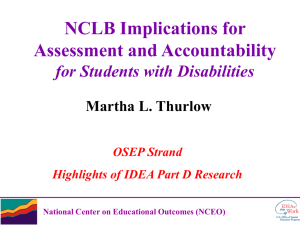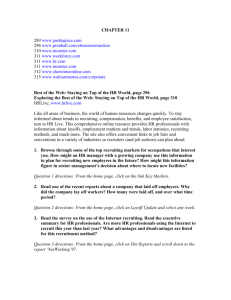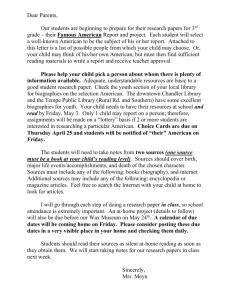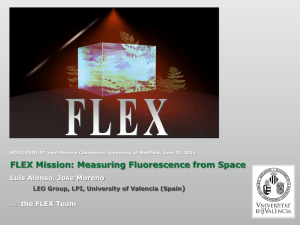Delaware stakeholders - University of Delaware
advertisement
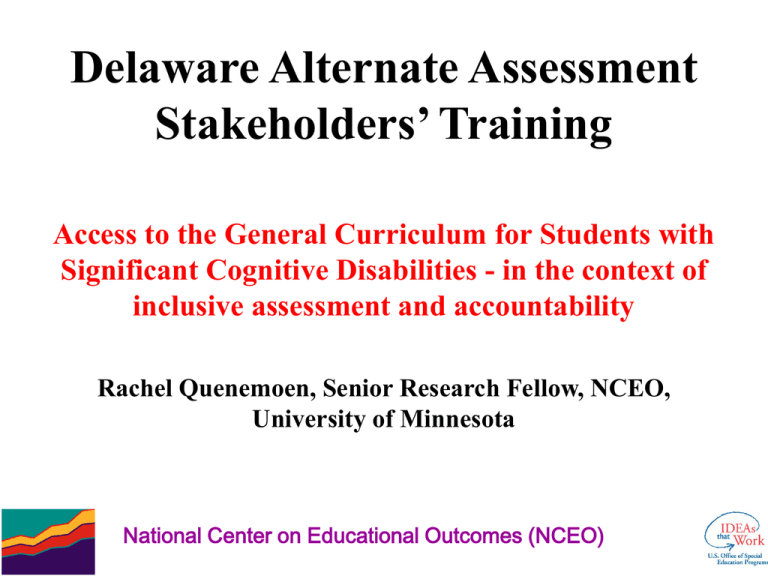
Delaware Alternate Assessment Stakeholders’ Training Access to the General Curriculum for Students with Significant Cognitive Disabilities - in the context of inclusive assessment and accountability Rachel Quenemoen, Senior Research Fellow, NCEO, University of Minnesota National Center on Educational Outcomes (NCEO) Visit: www.nceo.info or Search for NCEO Web site includes: Topic introduction Frequently Asked Questions Online and Other Resources National Center on Educational Outcomes (NCEO) http://www.naacpartners.org/Products/products.htm National Alternate Assessment Center University of Kentucky – Jacqui Kearns, Director; Harold Kleinert, Co-Director NCEO, University of Minnesota – Martha Thurlow, Rachel Quenemoen University of North Carolina, Charlotte – Diane Browder, Claudia Flowers CAST – Tracey Hall National Center on Educational Outcomes (NCEO) Big Ideas for Today • History of Curriculum for Students with Significant Cognitive Disabilities • Walk the Wall – tap into our expertise and understanding • Accessing the General Curriculum – a Four Step Process – one student at a time! • Is it REALLY reading? Is it REALLY math? • Practice • Discussion National Center on Educational Outcomes (NCEO) Changing Curricular Context for Students with Significant Cognitive Disabilities • Early 1970s – Adapting infant/early childhood curriculum for students with the most significant disabilities of all ages • 1980s – – Rejected “developmental model” Functional, life skills curriculum emerged • 1990s – – – Also: social inclusion focus Also: self determination focus Assistive technology • 2000 – – – General curriculum access (academic content) Plus earlier priorities (functional, social, self determination) Digitally accessible materials National Center on Educational Outcomes (NCEO) Walk the Wall • • • • • • • • • Walk the Wall Divide into 4 teams – A, B, C, D Move to designated area Divide each team into 4 main groups (1, 2, 3, 4) - 1 group for each curricular area Assign recorder within each subgroup, clarify nature of era Record pros and cons for your curriculum era (timed) – Move on to next curriculum era when directed Review pros and cons and add further points (timed) – Move on to next curriculum era when directed Repeat until back to starting point (less time for each) (4 curricular areas) Review and Report Out National Center on Educational Outcomes (NCEO) Some Answers - Diane Browder • We do not know if we can teach academics to this population until we try; we have emerging evidence from teachers/ students we need to capture in our research • We have to give ourselves permission to teach some skills that build understanding; not every skill will be usable at Walmart today • We can align with grade level content if we use the concepts of age appropriate and partial participation used before for CBI; but we need to do deeper thinking about this concept National Center on Educational Outcomes (NCEO) Browder: What Is Reading, Math, and Science for this Population? • How we figured out age appropriate life skills – Consider Ss age – Identify life domain (e.g., community) – What do typical peers this age do in this domain? – How can we make these same activities accessible for Ss with sig disabilities? – For those with more significant disabilities, what meaningful partial participation can we teach? • Using the same strategy for academic learning – Consider the Ss grade level (comparable by age) – Identify the academic domains and components of these (standards) – Consider what activities typical peers do to learn these standards – Make these activities accessible for this population – For those with more sig disabilities, identify meaningful partial participation National Center on Educational Outcomes (NCEO) Browder: Defining the Construct • Academic content (reading, math, science) for students with SCD should be as close as possible to the grade level content (themes, topics, materials, activities) but with a) adaptations in delivery of content to make it accessible to students level of understanding and b) differentiation in level of expectation for student achievement to focus on prioritized target skills within that content that are both meaningful to student and build growth in academic learning. National Center on Educational Outcomes (NCEO) New Resources • Browder, D.M., Ahlgrim-Delzell, L., Courtade-Little, G., & Snell, M.E. (2006). Access to the general curriculum. In M.E. Snell & F. Brown (Eds.). Instruction of students with severe disabilities. Upper Saddle River, NJ: Prentice Hall. • Browder, D.M. & Courtade-Little, G. (2005). Aligning IEPs to academic content standards. Madison, WI: Attainment Co. • Browder, D.M., & Spooner, F.H. (In press for 2006). Teaching reading, math, and science to students with significant cognitive disabilities. Baltimore: Paul H. Brookes. National Center on Educational Outcomes (NCEO) Contact Information • Diane M. Browder, PhD Snyder Distinguished Professor of Special Education Department of Special Education University of North Carolina at Charlotte 9201 University City Blvd Charlotte, NC 28223 Dbrowder@email.uncc.edu National Center on Educational Outcomes (NCEO) Accessing the General Curriculum: A stepwise process National Center on Educational Outcomes (NCEO) Four Steps to Access 1. Identify or link to the appropriate standard(s) 2. Define the outcome(s) of instruction 3. Identify the instructional activities 4. Target specific objectives from the IEP [Adapted – Kearns, Burdge and Kleinert (in press)] National Center on Educational Outcomes (NCEO) 1. LINK TO THE APPROPRIATE STANDARD(S). State/District Standard Grade Level Standard(s) Critical Function(s) Individualized Extensions 2. DEFINE THE OUTCOME(S) OF INSTRUCTION. Outcomes for All Students Prioritized Outcomes Supports 3. IDENTIFY THE INSTRUCTIONAL ACTIVITIES. Instructional Activities Active Participation 4. TARGET SPECIFIC OBJECTIVES FROM THE IEP. Instructional Activities Embedded Standards Based Objectives Other Embedded Objectives Burdge & Kleinert (in press) National Center on Educational Kearns, Outcomes (NCEO) Step 1 1. Identify or link to the appropriate content standard(s). – State/District Standard – Grade Level Standard(s) – Determine what the standard is about National Center on Educational Outcomes (NCEO) Step 2 2. Define the outcome(s) of instruction. – Outcomes for all students – Prioritized outcomes for student with IEP – Supports typically used for student with IEP National Center on Educational Outcomes (NCEO) Prioritized Outcomes • Reduce complexity • Reduce number of skills/concepts Should open up opportunities to access content standards vs. limiting participation in instructional activities National Center on Educational Outcomes (NCEO) Step 3 3. Identify the instructional activities. – Instructional activities for all students – Active participation for student with IEP – Previously identified and/or additional supports specific to instructional activities National Center on Educational Outcomes (NCEO) Typical Types of Instructional Activities • • • • • • Lecture and note-taking Cooperative learning groups Research Practice activities and homework Culminating projects Classroom based assessment National Center on Educational Outcomes (NCEO) Active Participation • Must be meaningful • Is based on student strengths • Moves student towards learning of prioritized outcomes/grade level content standard National Center on Educational Outcomes (NCEO) Determine Supports Needed • Refer to the supports listed on IEP • Select the supports that will help the student participate meaningfully • Identify any additional supports that are needed to match the instructional task and environment • Possibly create a menu of support ideas National Center on Educational Outcomes (NCEO) Guiding Questions for Selecting Supports • Is the student actively participating in each part of the instructional activity? • What is needed to engage the student in instruction? • Does the student have a means to demonstrate the knowledge, skills, concepts acquired? National Center on Educational Outcomes (NCEO) Step 4 4. Target specific objectives from the IEP – Instructional activities – Embedded standards based objectives – Other embedded objectives National Center on Educational Outcomes (NCEO) Embedding IEP Objectives • List the instructional activities in which IEP objectives can be addressed • Plan how to provide direct instruction on IEP skills based on content standards • Plan how to provide direct instruction and practice on other functional IEP objectives National Center on Educational Outcomes (NCEO) Example - Ryan • 13 year-old middle school student • Significant cognitive disability • Can: – identify picture symbols – emerging sight word vocabulary of 35 words – answer basic recall questions – independently write personal information – basic computer use – speaks using 2-3 word phrases National Center on Educational Outcomes (NCEO) Ryan’s IEP Goals • Increase reading vocabulary words • Identify picture symbols related to curriculum • Increase reading/listening comprehension • Express thoughts in writing with words and picture symbols • Increase task completion National Center on Educational Outcomes (NCEO) Step 1: Standard • Standard: Students apply a wide range of strategies to comprehend, interpret, evaluate, and appreciate texts. They draw on their prior experience, their interactions with other readers and writers, their knowledge of word meaning and of other texts, their word identification strategies, and their understanding of textual features (e.g., sound-letter correspondence, sentence structure, context, graphics). (IRA/NCTE Standards for the English Language Arts) National Center on Educational Outcomes (NCEO) Grade Level Content Standard: 8th Grade Language Arts • Identify and explain vocabulary taken from text appropriate for middle school. What is the Content Standard About? • Increasing sight word vocabulary • Understanding vocabulary National Center on Educational Outcomes (NCEO) Step 2: Outcomes Based on an Instructional Unit of The Giver All Students Ryan • Identify unfamiliar vocabulary • Identifying unfamiliar from the text using sound-letter vocabulary from the text using correspondence, sentence graphics and context structure, context, and • Explain the meaning of those graphics same vocabulary words by • Explain the meaning of matching to a picture identified vocabulary words representing the concept. from each chapter • Ryan will have fewer • Identify vocabulary words with vocabulary words but will be multiple meanings and the exposed to the entire book meaning applicable to the context of this book National Center on Educational Outcomes (NCEO) Step 3: Instructional Activities • • • • All Students Ryan Read each chapter • listens to the chapter aloud in class – being read listen by following • looks at pictures that along in the book correspond to the text (i.e., picture of a boy, participate in class family, jobs, bike, etc.) discussion Answer questions. • Answers questions using pictures. National Center on Educational Outcomes (NCEO) Supports • Ryan’s IEP has identified the following supports – picture symbols – pictures – text reader – scribe as supports National Center on Educational Outcomes (NCEO) Instructional Activities Supports • Pictures or picture symbols that correspond to the text National Center on Educational Outcomes (NCEO) Step 4: Target specific objectives from the IEP • Identifies picture symbols when reading the text paired with symbols • Answers questions about the text using picture symbols. • Matches words to picture definition to complete sentences. • Completes class products within time limits. National Center on Educational Outcomes (NCEO) Ryan’s Work National Center on Educational Outcomes (NCEO) Ryan’s Work National Center on Educational Outcomes (NCEO) Discussion of 4-Step Process 1. Review and clarify each of the steps; reflect individually on the 2nd question, writing down key opportunities and barriers 2. FOR EACH STEP – identify opportunities; identify barriers for making this work across the state through a round robin recording 3. Select 1-3 key barriers – As a group, brainstorm solutions to barriers 4. Identify possible training or professional development strategies, including who, what, where, when National Center on Educational Outcomes (NCEO) Linking to Content Standards Is it Reading? Is it Mathematics? National Center on Educational Outcomes (NCEO) A close look at what is taught … Is it really content? Does it access the grade level content standard? Is it meaningful? National Center on Educational Outcomes (NCEO) Grade Level Curriculum + Expectations = Linkage Students with the most significant cognitive disabilities: • receive instruction on grade level content standards (may be at a lower complexity level) within the context of grade level curriculum ensuring that the intent of the grade level content standard remains intact • use the same materials, or adapted version of the materials, and appropriate assistive technology to gain access National Center on Educational Outcomes (NCEO) Some Words about “Functionality” Students with the most significant cognitive disabilities should: • be taught skills that will enhance their independence in the next critical environment – those skills must be embedded in natural routines and in socially valid contexts – those skills might not be assessed • be taught academic content because it is “functional” and socially valid • not have to wait until they are able to make a bed before they are taught to read or identify initial letter sounds or before they are taught literature • be presumed competent and not denied instruction offered to students of the same age (grade level content standards and curriculum) National Center on Educational Outcomes (NCEO) Is it Reading? • Individual states define reading in a variety of ways; some define reading comprehension separately from decoding. Please recognize that your state’s definition may result in a different interpretation of the following slides. National Center on Educational Outcomes (NCEO) Linking to a State Standard: Examples The State Standard the team considered: Students apply knowledge of language structure, language conventions (e.g., spelling and punctuation), media techniques, figurative language, and genre to create, critique, and discuss print and non-print texts. (NCTE) 10th grade: interpret figurative, symbolic, and/or idiomatic (e.g., jargon, dialect) language National Center on Educational Outcomes (NCEO) Is it Reading? Jordan is working on laundry skills. – Is this reading? No. Jordan is following verbal directions. – Does it link to the grade level content standard on interpreting figurative, symbolic, and/or idiomatic (e.g., jargon, dialect) language? No. – Is it meaningful? This may be an important skill for Jordan to work on so that he can be as independent as possible as he transitions from school and could be addressed though the IEP. National Center on Educational Outcomes (NCEO) Is it Reading? Jordan will identify and explain the meaning of 5 survival signs. – Is this reading? Yes. Jordan is both identifying the words and giving their meaning. – Does it link to the grade level content standard on interpreting figurative, symbolic, and/or idiomatic (e.g., jargon, dialect) language? No. These are functional words. – Is it meaningful? This may be an important functional reading goal to retain for the IEP, but keep searching for the goal that will promote learning the grade level standard. National Center on Educational Outcomes (NCEO) Jordan Is it Reading? will identify/explain idioms from “To Kill a Mocking Bird.” ⁻Is this reading? Yes. Jordan is selecting the idiom from a choice of two (answer and one distracter). ⁻ Does it link to the grade level content standard of interpreting figurative, symbolic, and/or idiomatic (e.g., jargon, dialect) language? Yes. Jordan is using idioms taken from the “To Kill a Mocking Bird” text. ⁻ Is it meaningful? Jordan is increasing his understanding of vocabulary and is being provided a context for peer interaction. National Center on Educational Outcomes (NCEO) Linking to a State Standard: Example The State Standard the team considered: Students are expected to identify, analyze and interpret a variety of genres, relating them to their own experience and knowledge. 8th grade: students will use, interpret, and analyze informational text (encyclopedias, articles, textbooks and reference sources) to locate information for school or personal use National Center on Educational Outcomes (NCEO) Is it Reading ? • Sarah will assemble materials according to verbal directions. ⁻Is this reading? No. Sarah is following verbal directions to put materials together. ⁻Does it link to the grade level content standard on students will use, interpret, and analyze informational text (encyclopedias, articles, textbooks and reference sources) to locate information for school or personal use. No. This is a functional task. ⁻Is it meaningful? This may be a skill used at home or possible practice for a work place task and could be developed as Sarah works towards transition to the work place. National Center on Educational Outcomes (NCEO) Is it Reading? Sarah will file food labels by the beginning letter of the product. ⁻Is this reading? Yes. Sarah is reading food labels and filing according to the beginning letter. ⁻Does it link to the grade level content standard on students will use, interpret, and analyze informational text (encyclopedias, articles, textbooks and reference sources) to locate information for school or personal use. No. Sarah is completing an assembly task. ⁻Is it meaningful? Sarah may find this a useful organization skill in her future which can still be addressed in the IEP. National Center on Educational Outcomes (NCEO) Is it Reading? Sarah is reading a biography about JK Rowling and identifying facts. – Is this reading? Yes. Sarah works with graphics as the biography is read to her and then answers questions. – Does it link to the grade level standard content on students will use, interpret, and analyze informational text to locate information for school or personal use. Yes. Sarah is reading and extracting information from a grade level text. – Is it meaningful? The Harry Potter books and movies are very popular. Extracting information from text is an important skill in all environments. National Center on Educational Outcomes (NCEO) Linking to a State Standard: Examples • The State Standard the team considered: – Represent and analyze mathematical situations and structures using algebraic symbols. – 9th grade: understand the meaning of equivalent forms of expressions, equations, inequalities, and relations National Center on Educational Outcomes (NCEO) Is it Math? Josh will pour pre-measured ingredients into a mixing bowl. – Is this really math? No. Josh has not participated in measuring. – Does it link to the grade level content standard on understanding the meaning of equivalent forms of expressions, equations, inequalities, and relations? N/A – Is this meaningful? This may be a skill to retain for the IEP in terms of following directions or motor development, but it does not promote understanding of mathematical procedures. National Center on Educational Outcomes (NCEO) Is it Math? Josh will identify specific coins and match them to the correct amount. ⁻Is this math? Yes. Josh is working on money skills. ⁻Does it link to the grade level content standard on understanding the meaning of equivalent forms of expressions, equations, inequalities, and relations? No. Typically this math skill is taught in the early grades. ⁻Is this meaningful? The IEP team may keep this goal to promote functional independence, but keep searching for a closer link. National Center on Educational Outcomes (NCEO) Is it Math? Josh will use pictures and manipulatives to solve for the variable. ⁻Is this math? Yes. Josh is solving for a variable. ⁻Does it link to the grade level content standard on understanding the meaning of equivalent forms of expressions, equations, inequalities, and relations? No. Josh is not required to look at both sides of the equation. ⁻Is it meaningful? It gives Josh another opportunity to problem solve. National Center on Educational Outcomes (NCEO) Is it Math? Josh uses manipulatives to solve for the variable within the equation. – Is it math? Yes. Josh is working on equations. – Does it link to the grade level content standard on understanding the meaning of equivalent forms of expressions, equations, inequalities, and relations? Yes. Josh is working on linear equations. – Is it meaningful? Josh is strengthening his basic number sense, in addition to using higher order thinking skills. National Center on Educational Outcomes (NCEO) Is it Math? Leslie will request more music using her head switch. – Is it math? – Does it link to the grade level content standard on understand the meaning of equivalent forms of expressions, equations, inequalities, and relations? – Is it meaningful? Leslie enjoys playing music and can practice switch use and communication skills. National Center on Educational Outcomes (NCEO) Is it Math? Leslie will identify the pattern from 3 distractors. – Is it math? Yes. Identifying patterns is basic to mathematical procedures. – Does it link to the grade level content standard on understand the meaning of equivalent forms of expressions, equations, inequalities, and relations? – Is it meaningful? It provides grounding for further understanding. National Center on Educational Outcomes (NCEO) Is it Math? Leslie will complete a function table using two variables. – Is it math? Yes. Leslie is working with linear equations – Does it link to the grade level content standard on understand the meaning of equivalent forms of expressions, equations, inequalities, and relations? – Is it meaningful? It provides grounding for further understanding. National Center on Educational Outcomes (NCEO) Summary • Finding the link between grade level content standards, alternate assessment, and instruction for students with the most significant cognitive disabilities – Why? To promote access to, and progress in, the general curriculum. – How? By sharing ideas as we travel new territory. National Center on Educational Outcomes (NCEO) References Colorado Enhanced Assessment Grant (2004). Design Elements for Mathematics. Don’t Fence Me In. Sample modified table, p. 74. Colorado Enhanced Assessment Grant (2004). Multimedia Glossary, Science, Math and Language Arts (developed with Classroom Suite, IntelliTools, Inc.). Colorado Enhanced Assessment Grant (2004). Reading Biographies and Expository Writing. Whose Life Is It Anyway? Sample adaptation of Biography Fact Chart (using Boardmaker by Mayer-Johnson), p. 19. NCTE, National Council for Teachers of English. Standards for the English Language Arts. Available on line, http://www.ncte.org/about/over/standards/110846.htm. National Center on Educational Outcomes (NCEO) Working with Draft Examples • Identify the targeted grade level content standard(s). • State the activity. Clarify. • Is it math? Is it reading? • Is it meaningful? • Does it link to the grade level content standard? • How can it be tailored, amended, rethought? National Center on Educational Outcomes (NCEO) SMALL GROUP REPORT OUT • Overview of what you found • What was clear, what was not • Ideas for developing and disseminating examples • Training: who, what, when, where, how – how this may link to Four Steps to Access National Center on Educational Outcomes (NCEO) Advent of Assistive Technology • Provides multiple means of representation of content (e.g., words, pictures, symbols, objects) • Provides engagement alternatives (e.g., use of computer, digital materials) • Provides multiple means of expression (e.g., communication systems) (CAST, 2002) National Center on Educational Outcomes (NCEO) “Active Participation” Cheap Talk 4 (Enabling Devices) Step By Step Communicator, Abel Net DynaVox 3100 Communication devices must provide a means of active participationPicture Exchange within the Communication System, PECS (Pyramid Educational curriculum Consultants) National Center on Educational Outcomes (NCEO) “Active Participation” - reading with... .. graphics/symbols (Writing with Symbols 2000, Widgit) .. a communication aid (Step-by-Step, AbelNet) .. objects .. tactile cues National Center on Educational Outcomes (NCEO) “Active Participation” - writing with… ..word prediction (Read and Write Gold, textHELP) .. a custom overlay and adaptive keyboard (Overlay Maker, IntelliTools) ..webbing software (Inspiration) A portable keyboard (AlphaSmart) National Center on Educational Outcomes (NCEO) “Active Participation” - writing with .. individual laminated symbols secured with Velcro (Boardmaker, Meyer-Johnson) .. word stamps .. sentence strips in science ● ● The plant needs sunlight. .. pictures – drawn, magazine National Center on Educational Outcomes (NCEO) Food for thought: Alignment ideas Borrowed from Diane Browder National Center on Educational Outcomes (NCEO) BROWDER: Transformation Process Summary • Define the construct (gen ed expert) • How gen ed would teach it (gen ed expert) • Depth of knowledge (gen ed) – Can this DOK be retained with creativity? (sped idea…gen ed validate) • Prerequisite skills (gen ed describes) – Sped Ed what to adapt or teach • State the extension • Give examples of target skills/activities (for assessment or instruction) National Center on Educational Outcomes (NCEO) Example: Biographies Grade Level Achievement • Standard – Compare and contrast elements of biographies • Symbolic Level: – Reads and writes at grade level • Content – Biographies of well known Americans • Depth of knowledge – Level 3: requires connecting ideas • Activities/skills – Silent reading of biography; answer questions about comparisons; compose biography with all elements National Center on Educational Outcomes (NCEO) Modified Achievement? • Standard – Compare and contrast elements of biographies • Symbolic Level: – Reads and writes below grade level • Content – Biographies of well known Americans using adapted text from lower grade level; or read aloud text • Depth of knowledge – Level 3: requires connecting ideas • Activities/skills – Silent reading of biography (adapted text/read aloud); answer questions about comparisons using a template that cues elements; compose biography filling in template with all elements National Center on Educational Outcomes (NCEO) Alternate Achievement Level 1- Symbolic • Standard – Compare and contrast elements of biographies • Symbolic Level: – Reads sight words & sentences with pic symbols; writes sight words or can circle large vocabulary of picture symbols • Content – Biographies of well known Americans • Depth of knowledge – Level 3: requires connecting ideas • Activities/skills – Read aloud biography written in simple sentences with picture cues; circle pictures to answer questions about comparisons; compose biography by selecting pictures and making captions National Center on Educational Outcomes (NCEO) Alternate Achievement Level 2- Early Symbolic • Standard – Compare and contrast elements of biographies • Symbolic Level – Recognizes a few picture symbols; recognizes larger number familiar objects and can use some symbolically • Content – Biographies of well known Americans • Depth of knowledge – Level 2: comprehension • Activities/skills – Simplified text with pictures and repeated lines and vocabulary read to student about; student selects pictures to answer question about the story; puts pictures into circles to show “same” and “different” to compare biography with own life story National Center on Educational Outcomes (NCEO) Alternate Achievement Level 3- Presymbolic • Standard – Compare and contrast elements of biographies • Symbolic Level – Picture recognition is inconsistent, must be paired with objects; communicates by looking at/ moving to objects or people • Content – Biographies of well known Americans • Depth of knowledge – Level 1: recall/ matching • Activities/skills – Adapted text with pictures read with student; objects also used to give meaning; student looks at/ points to objects from story National Center on Educational Outcomes (NCEO) Alternate AchievementSpecial Consideration • Standard – Compare and contrast elements of biographies • Symbolic Level – No consistent voluntary responding that can be used reliably (continue to observe for response/ AT consultations) • Content – Biographies of well known Americans • Depth of knowledge – Level ?: Awareness (probably not scored proficient) • Activities/skills – Adapted text with pictures read with student; objects also used to give meaning; note whether student made any response to these stimuli (change in respiration, opened eyes, sound) National Center on Educational Outcomes (NCEO) Trade Off: Changing the Content and Increasing DOK • Standard – Compare and contrast elements of biographies • Symbolic Level – Recognizes a few picture symbols; recognizes larger number familiar objects and can use some symbolically • Content – Biographies of family members; autobiography • Depth of knowledge – Level 3: connections • Activities/skills – Adapted text with pictures read with student; objects also used to give meaning; student compares elements of family member’s and own story into “same”/ “different” charts using pictures/objects National Center on Educational Outcomes (NCEO) Trade Off: Keeping Content; less “academic” response • Standard – Compare and contrast elements of biographies • Symbolic Level – Recognizes a few picture symbols; recognizes larger number familiar objects and can use some symbolically • Content – Biographies of famous Americans • Depth of knowledge – Level 2: Comprehension • Activities/skills – Adapted text with pictures read with student; recreates biography by placing objects related to story on shelf for biography display as teacher rereads story National Center on Educational Outcomes (NCEO) Rule of Thumb… • “Work it down” – Begin with content standard at grade level; how typical student would show understanding; typical materials/ activities – Translate one level to symbolic – Then translate to early symbolic – Then translate to presymbolic National Center on Educational Outcomes (NCEO) Leaping from standard to presymbolic leads to…. • Standard – Compare and contrast elements of biographies – “This is too hard for our students. Let’s make it a communication activity.” • Activities/skills – Use assistive technology to communicate basic needs National Center on Educational Outcomes (NCEO) Validation Check • Will the skill have meaning for the student? • When looking at the skill in isolation, can you still identify the academic domain? Or is it no longer reading, math, etc.? • Could a curriculum content expert link it back to the specific state standard? National Center on Educational Outcomes (NCEO) Final Thought: Deep Curriculum Alignment • Deep curriculum alignment occurs when what is tested is what is taught. It is the principle of “no surprises” for children • However, deep curriculum alignment also means that the taught curriculum extends beyond what is tested National Center on Educational Outcomes (NCEO)

